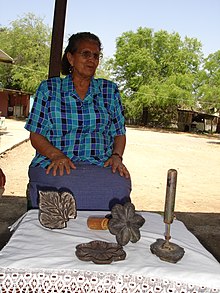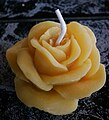|
Artificial plants
  Artificial plants are imitations of natural plants used for commercial or residential decoration. They are sometimes made for scientific purposes (the collection of glass flowers at Harvard University, for example, illustrates the flora of the United States).[1] Artificial plants vary widely from mass-produced varieties that are distinguishable from real plants by casual observation to highly detailed botanical or artistic specimens. Materials used in their manufacture have included painted linen and shavings of stained horn in ancient Egypt, gold and silver in ancient Rome, rice-paper in China, silkworm cocoons in Italy, colored feathers in South America, and wax and tinted shells.[1][2] Modern techniques involve carved or formed soap, nylon netting stretched over wire frames, ground clay, and mass-produced injection plastic mouldings. Polyester has been the main material for manufacturing artificial flowers since the 1970s. Most artificial flowers in the market nowadays are made of polyester fabric and plastic.[3] ProductionThe industry is now highly specialized with several different manufacturing processes. Hundreds of artificial flower factories in the Pearl River delta area of Guangdong province in China have been built since the early 1980s. Thousands of 40-foot containers of polyester flowers and plants are exported to many countries every year.[citation needed] Polyester and paper Five main processes may be distinguished:
While the material most often used to make artificial flowers is polyester fabric, both paper and cloth flowers are also made with origami.[4] Nylon stocking flowersThe art of nylon flower making is an easy to learn craft which uses simple tools and inexpensive material to achieve stunning results. Nylon flower making enjoyed a brief popularity in the United States in the 1970s and soon became very popular in Japan. In recent years, the craft's popularity has spread Asia, Europe and Australia. With the advent of new colors and materials, the art has expanded to infinite new possibilities of nylon flower making.[5] The basic materials needed to make nylon flowers include: wire, stem wire, nylon stocking, nylon threading, floral tape and stamen. Some flowers require cotton balls or sheets (or batting), white glue, acrylic paint and paint brushes.[5] Silk flowersSilk flowers are crafted from a protein fibre spun by the silk worm, producing lifelike flowers. Flowers described as being made of silk with a "real touch technique" are not made of silk, but rather are made of polyester, polymers and plastics.[6] Moreover, textile items made of polyester but marketed as "silk" violate the US federal law – specifically the 1959 Textile Fiber Products Identification Act.[7] SoapThere are two methods:
ClayClay flowers are made by hand from special air-dry polymer clay or cold porcelain, steel wire, paint, glue, tape and sometimes paper and foam as a filler. With the help of cutters, where each flower has its own cutter set, the parts are cut from the still soft clay and then formed with specially designed tools. After drying, these parts are, when needed, painted with precision and then very precisely assembled into a whole flower. When made by a skilful artisan, clay flowers can be very realistic. From Thailand, where this art is very popular, it has spread to Europe, Russia and the US. Glass Glass is melted and blown by hand into flower shapes. Working with glass at high temperatures to form a flower is very difficult, which is why glass flowers are much more expensive than typical artificial flowers. PlasticInjection moulding is used for mass manufacture of plastic flowers. Plastic is injected into a preformed metal die. SimulacraceaeThe journal Ethnobotany Research and Applications published a tongue-in-cheek paper that claims to be the culmination of a six-year project in the exhaustive taxonomy of artificial plants, and lumped the group into a single family called the Simulacraceae ("the family of simulated plants").[8] History Floral wreaths made by the ancient Egyptians were formed from thin plates of horn stained in different colors. They also sometimes consisted of leaves of copper, gilt or were silvered over. The ancient Romans excelled in the art of imitating flowers in wax and in this branch of the art attained a degree of perfection which has not been approached in modern times. Crassus, renowned for his wealth, gave to the victors in the games he celebrated at Rome crowns of artificial leaves made of gold and silver.[2] In more recent times, Italians were the first to acquire celebrity for the skill and taste they displayed in this manufacture. Later English, American, and especially French manufactures were celebrated. The Chinese and Japanese show great dexterity in this work. These early artificial flowers were made out of many-coloured ribbons which were twisted together and attached to small pieces of wire. But these first attempts were decidedly crude.[2] In the first half of the 19th century, the Swedish artist Emma Fürstenhoff became internationally renowned in Europe for her artificial flower arrangements of wax in a technique regarded as a novelty in contemporary Europe.[9] Wax flower sculptures were popular in the 1840s and 1850s in Britain, with noted sculptors including the London-based Emma Peachey and the Mintorn family.[10] In the 1910s, Beat-Sofi Granqvist studied the manufacture of artificial flowers in Germany. After returning to Finland, she founded Finland's first artificial flower factory, next to her apartment at Pieni Roobertinkatu 4-6.[11][12][13] In the course of time feathers were substituted for ribbons, a more delicate material, but one to which it was not so easy to give the requisite shades of color. The plumage of the birds of South America was adapted for artificial flowers on account of the brilliancy and permanence of the tints, and the natives of that continent long practised with success the making of feather flowers. The London Zoo contains a collection of artificial flowers made out of the feathers of hummingbirds.[2] Gallery
See alsoReferences
|






